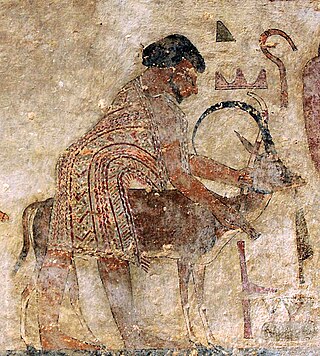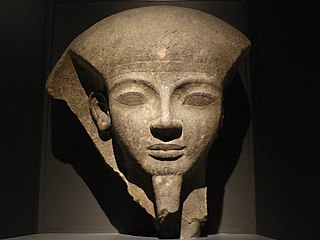
The Philistines were an ancient people who lived on the south coast of Canaan during the Iron Age in a confederation of city-states generally referred to as Philistia.

Canaan was a Semitic-speaking civilization and region of the Southern Levant in the Ancient Near East during the late 2nd millennium BC. Canaan had significant geopolitical importance in the Late Bronze Age Amarna Period as the area where the spheres of interest of the Egyptian, Hittite, Mitanni, and Assyrian Empires converged or overlapped. Much of present-day knowledge about Canaan stems from archaeological excavation in this area at sites such as Tel Hazor, Tel Megiddo, En Esur, and Gezer.

Set is a god of deserts, storms, disorder, violence, and foreigners in ancient Egyptian religion. In Ancient Greek, the god's name is given as Sēth. Set had a positive role where he accompanies Ra on his barque to repel Apep (Apophis), the serpent of Chaos. Set had a vital role as a reconciled combatant. He was lord of the Red Land (desert), where he was the balance to Horus' role as lord of the Black Land.

Philistia was a confederation of five main cities or pentapolis in the Southwest Levant, made up of principally Gaza, Ashkelon, Ashdod, Ekron, and Gath, and for a time, Jaffa.
Montu was a falcon-god of war in the ancient Egyptian religion, an embodiment of the conquering vitality of the pharaoh. He was particularly worshipped in Upper Egypt and in the district of Thebes.
[Ramesses II] whom victory was foretold as he came from the womb,
Whom valor was given while in the egg,
Bull firm of heart as he treads the arena,
Godly king going forth like Montu on victory day.

The Hyksos, in modern Egyptology, are the kings of the Fifteenth Dynasty of Egypt. Their seat of power was the city of Avaris in the Nile Delta, from where they ruled over Lower Egypt and Middle Egypt up to Cusae.

Menpehtyre Ramesses I was the founding pharaoh of ancient Egypt's 19th Dynasty. The dates for his short reign are not completely known but the timeline of late 1292–1290 BC is frequently cited as well as 1295–1294 BC. While Ramesses I was the founder of the 19th Dynasty, his brief reign mainly serves to mark the transition between the reign of Horemheb, who had stabilized Egypt in the late 18th Dynasty, and the rule of the powerful pharaohs of his own dynasty, in particular his son Seti I, and grandson Ramesses II.

The Battle of Kadesh took place in the 13th century BC between the Egyptian Empire led by pharaoh Ramesses II and the Hittite Empire led by king Muwatalli II. Their armies engaged each other at the Orontes River, just upstream of Lake Homs and near the archaeological site of Kadesh, along what is today the Lebanon–Syria border.

The Second Intermediate Period dates from 1700 to 1550 BC. It marks a period when ancient Egypt was divided into smaller dynasties for a second time, between the end of the Middle Kingdom and the start of the New Kingdom. The concept of a Second Intermediate Period generally includes the 13th through to the 17th dynasties, however there is no universal agreement in Egyptology about how to define the period.

The New Kingdom, also referred to as the Egyptian Empire, was the ancient Egyptian state between the 16th century BC and the 11th century BC. This period of ancient Egyptian history covers the Eighteenth, Nineteenth, and Twentieth Dynasties. Through radiocarbon dating, the establishment of the New Kingdom has been placed between 1570 BC and 1544 BC. The New Kingdom followed the Second Intermediate Period and was succeeded by the Third Intermediate Period. It was the most prosperous time for the Egyptian people and marked the peak of Egypt's power.

Avaris was the Hyksos capital of Egypt located at the modern site of Tell el-Dab'a in the northeastern region of the Nile Delta. As the main course of the Nile migrated eastward, its position at the hub of Egypt's delta emporia made it a major capital suitable for trade. It was occupied from about the 18th century BC until its capture by Ahmose I.

Merneptah or Merenptah was the fourth pharaoh of the Nineteenth Dynasty of Ancient Egypt. According to contemporary historical records, he ruled Egypt for almost ten years, from late July or early August 1213 until his death on 2 May 1203. He was the first royal-born pharaoh since Tutankhamun of the Eighteenth Dynasty of Egypt.

Ramesses VI Nebmaatre-Meryamun was the fifth ruler of the Twentieth Dynasty of Egypt. He reigned for about eight years in the mid-to-late 12th century BC and was a son of Ramesses III and queen Iset Ta-Hemdjert. As a prince, he was known as Ramesses Amunherkhepeshef and held the titles of royal scribe and cavalry general. He was succeeded by his son, Ramesses VII Itamun, whom he had fathered with queen Nubkhesbed.
The Book of Gates is an ancient Egyptian funerary text dating from the New Kingdom. The Book of Gates is long and detailed, consisting of one hundred scenes. It narrates the passage of a newly deceased soul into the next world journeying with the sun god, Ra, through the underworld during the hours of the night towards his resurrection. The soul is required to pass through a series of 'gates' at each hour of the journey. Each gate is guarded by a different serpent deity that is associated with a different goddess. It is important that the deceased knows the names of each guardian. Depictions of the judgment of the dead are shown in the last three hours. The text implies that some people will pass through unharmed, but others will suffer torment in a lake of fire. At the end of Ra's journey through the underworld, he emerges anew to take his place back in the sky.

The Fifteenth Dynasty was a foreign dynasty of ancient Egypt. It was founded by Salitis, a Hyksos from West Asia whose people had invaded the country and conquered Lower Egypt. The 15th, 16th, and 17th Dynasties of ancient Egypt are often combined under the group title, Second Intermediate Period. The 15th Dynasty dates approximately from 1650 to 1550 BC.

Bay, also called Ramesse Khamenteru, was an important Asiatic official in ancient Egypt, who rose to prominence and high office under Seti II Userkheperure Setepenre and later became an influential powerbroker in the closing stages of the 19th Dynasty. He used to be possibly identified with Irsu mentioned in the Great Harris Papyrus, although no contemporary source connects Bay with Irsu and the connection has since been disproven due to the differences in the years that they died.

Maathorneferure was an ancient Egyptian queen, the Great Royal Wife of Ramesses II.

Ramesses II, commonly known as Ramesses the Great, was an Egyptian pharaoh. He was the third ruler of the Nineteenth Dynasty. Along with Thutmose III of the Eighteenth Dynasty, he is often regarded as the greatest, most celebrated, and most powerful pharaoh of the New Kingdom, which itself was the most powerful period of ancient Egypt. He is also widely considered one of ancient Egypt's most successful warrior pharaohs, conducting no fewer than 15 military campaigns, all resulting in victories, excluding the Battle of Kadesh, generally considered a stalemate.
The High Priest of Ra or of Re was known in Egyptian as the wr-mꜢw, which translates as Greatest of Seers.

Anra scarabs are scarab seals dating to the Second Intermediate Period found in the Levant, Egypt and Nubia. Anra scarabs are identified by an undeciphered and variable sequence of Egyptian hieroglyphs on the base of the scarab which always include the symbols a, n and r. As anra scarabs have overwhelmingly been found in Palestine (~80%), it has been suggested it was marketed by the contemporaneous 15th Dynasty for the Canaanites.















